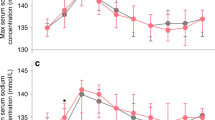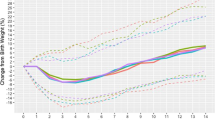Abstract
Background:
High fluid volumes may increase neonatal morbidity. However, evidence supporting fluid restriction is inconclusive and restricting fluids may restrict caloric intake.
Objective:
To determine if higher fluid intake was associated with increased risk of patent ductus arteriosus (PDA) or bronchopulmonary dysplasia (BPD) in extremely low birth weight (ELBW) infants.
Study Design:
A total of 204 ELBW (⩽32 weeks, ⩽1250 g) infant survivors were grouped into low-, intermediate- and high-fluid groups. χ2 analyzed proportions of subjects with and without morbidities across groups. Logistic regression quantified increased risk of PDA or BPD associated with fluid intake while controlling for confounders. Analysis of variance compared differences in caloric intake across groups.
Result:
After controlling for gestational age, severity of illness and weight change, fluid intake on day 2 (odds ratio (OR) 1.014; confidence interval (CI) 1.001 to 1.028) and day 3 (OR 1.022; CI 1.004 to 1.040) was associated with increased risk of PDA.
Conclusion:
High fluid intake (>170 ml kg−1 day−1) in the first days of life is associated with increased risk of PDA.
This is a preview of subscription content, access via your institution
Access options
Subscribe to this journal
Receive 12 print issues and online access
$259.00 per year
only $21.58 per issue
Buy this article
- Purchase on Springer Link
- Instant access to full article PDF
Prices may be subject to local taxes which are calculated during checkout
Similar content being viewed by others
References
Bell EF, Warburton D, Stonestreet BS, Oh W . Effect of fluid administration on the development of symptomatic patent ductus arteriosus and congestive heart failure in premature infants. N Engl J Med 1980; 302 (11): 598–604.
Brown ER, Stark A, Sosenko I, Lawson EE, Avery ME . Bronchopulmonary dysplasia: possible relationship to pulmonary edema. J Pediatr 1978; 92 (6): 982–984.
Hallman M, Merritt TA, Bry K, Berry C . Association between neonatal care practices and efficacy of exogenous human surfactant: results of a bicenter randomized trial. Pediatrics 1993; 91 (3): 552–560.
Marshall DD, Kotelchuck M, Young TE, Bose CL, Kruyer L, O’Shea TM . Risk factors for chronic lung disease in the surfactant era: a North Carolina population-based study of very low birth weight infants. North Carolina Neonatologists Association. Pediatrics 1999; 104 (6): 1345–1350.
Palta M, Gabbert D, Weinstein MR, Peters ME . Multivariate assessment of traditional risk factors for chronic lung disease in very low birth weight neonates. The newborn lung project. J Pediatr 1991; 119 (2): 285–292.
Shaffer SG, Bradt SK, Hall RT . Postnatal changes in total body water and extracellular volume in the preterm infant with respiratory distress syndrome. J Pediatr 1986; 109 (3): 509–514.
Spitzer AR, Fox WW, Delivoria-Papadopoulos M . Maximum diuresis—a factor in predicting recovery from respiratory distress syndrome and the development of bronchopulmonary dysplasia. J Pediatr 1981; 98 (3): 476–479.
Stevenson JG . Fluid administration in the association of patent ductus arteriosus complicating respiratory distress syndrome. J Pediatr 1977; 90 (2): 257–261.
Tammela OK, Koivisto ME . Fluid restriction for preventing bronchopulmonary dysplasia? Reduced fluid intake during the first weeks of life improves the outcome of low-birth-weight infants. Acta Paediatr 1992; 81 (3): 207–212.
Tooley WH . Epidemiology of bronchopulmonary dysplasia. J Pediatr 1979; 95 (5 Part 2): 851–858.
Van Marter LJ, Leviton A, Allred EN, Pagano M, Kuban KC . Hydration during the first days of life and the risk of bronchopulmonary dysplasia in low birth weight infants. J Pediatr 1990; 116 (6): 942–949.
Wadhawan R, Oh W, Perritt R, Laptook AR, Poole K, Wright LL et al. Association between early postnatal weight loss and death or BPD in small and appropriate for gestational age extremely low-birth-weight infants. J Perinatol 2007; 27 (6): 359–364.
Aggarwal R, Deorari AK, Paul VK . Fluid and electrolyte management in term and preterm neonates. Indian J Pediatr 2001; 68 (12): 1139–1142.
Baumgart S, Costarino AT . Water and electrolyte metabolism of the micropremie. Clin Perinatol 2000; 27 (1): 131–146, vi–vii.
Costarino A, Baumgart S . Modern fluid and electrolyte management of the critically ill premature infant. Pediatr Clin N Am 1986; 33 (1): 153–178.
Furzan JA, Reisch J, Tyson JE, Laird P, Rosenfeld CR . Incidence and risk factors for symptomatic patent ductus arteriosus among inborn very-low-birth-weight infants. Early Hum Dev 1985; 12 (1): 39–48.
Mouzinho AI, Rosenfeld CR, Risser R . Symptomatic patent ductus arteriosus in very-low-birth-weight infants: 1987–1989. Early Hum Dev 1991; 27 (1–2): 65–77.
Shaffer SG, Weismann DN . Fluid requirements in the preterm infant. Clin Perinatol 1992; 19 (1): 233–250.
Hay Jr WW, Lucas A, Heird WC, Ziegler E, Levin E, Grave GD et al. Workshop summary: nutrition of the extremely low birth weight infant. Pediatrics 1999; 104 (6): 1360–1368.
Thureen PJ . Early aggressive nutrition in the neonate. Pediatr Rev 1999; 20 (9): e45–e55.
Shah PS . Current perspectives on the prevention and management of chronic lung disease in preterm infants. Paediatr Drugs 2003; 5 (7): 463–480.
Sosenko IR, Frank L . Nutritional influences on lung development and protection against chronic lung disease. Semin Perinatol 1991; 15 (6): 462–468.
American Academy of Pediatrics Committee on Nutrition. Nutritional needs of low-birth-weight infants. Pediatrics 1985; 75 (5): 976–986.
Richardson DK, Corcoran JD, Escobar GJ, Lee SK . SNAP-II and SNAPPE-II: simplified newborn illness severity and mortality risk scores. J Pediatr 2001; 138 (1): 92–100.
Wu PY, Hodgman JE . Insensible water loss in preterm infants: changes with postnatal development and non-ionizing radiant energy. Pediatrics 1974; 54 (6): 704–712.
American Academy of Pediatrics, Committee on Nutrition. Nutritional needs of the preterm infant. In: Fleinman, RE (ed.) Pediatric Nutrition Handbook, 5th edn. American Academy of Pediatrics: Elk Grove Village, 2004 pp 23–54.
Spahr RC, Klein AM, Brown DR, Holzman IR, MacDonald HM . Fluid administration and bronchopulmonary dysplasia. The lack of an association. Am J Dis Child 1980; 134 (10): 958–960.
Kavvadia V, Greenough A, Dimitriou G, Hooper R . Comparison of the effect of two fluid input regimens on perinatal lung function in ventilated infants of very low birthweight. Eur J Pediatr 1999; 158 (11): 917–922.
Kavvadia V, Greenough A, Dimitriou G, Hooper R . Randomised trial of fluid restriction in ventilated very low birthweight infants. Arch Dis Child Fetal Neonatal Ed 2000; 83 (2): F91–F96.
Lorenz JM, Kleinman LI, Kotagal UR, Reller MD . Water balance in very low-birth-weight infants: relationship to water and sodium intake and effect on outcome. J Pediatr 1982; 101 (3): 423–432.
Bell EF, Acarregui MJ . Restricted versus liberal water intake for preventing morbidity and mortality in preterm infants. Cochrane Database Syst Rev 2001 (3): 1–13, CD000503.
Author information
Authors and Affiliations
Corresponding author
Rights and permissions
About this article
Cite this article
Stephens, B., Gargus, R., Walden, R. et al. Fluid regimens in the first week of life may increase risk of patent ductus arteriosus in extremely low birth weight infants. J Perinatol 28, 123–128 (2008). https://doi.org/10.1038/sj.jp.7211895
Received:
Revised:
Accepted:
Published:
Issue Date:
DOI: https://doi.org/10.1038/sj.jp.7211895
Keywords
This article is cited by
-
Nutrition of the preterm infant with persistent ductus arteriosus: existing evidence and practical implications
Pediatric Research (2023)
-
Neonatal fluid overload—ignorance is no longer bliss
Pediatric Nephrology (2023)
-
Postnatal maximal weight loss, fluid administration, and outcomes in extremely preterm newborns
Journal of Perinatology (2022)
-
The role of furosemide and fluid management for a hemodynamically significant patent ductus arteriosus in premature infants
Journal of Perinatology (2022)
-
Fluid restriction in management of patent ductus arteriosus in Italy: a nationwide survey
European Journal of Pediatrics (2022)



